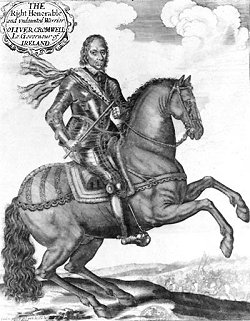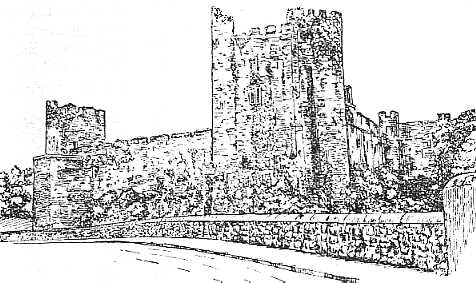





CONFLICTS IN IRELAND
The Fame of Tipperary Group present...
 |
 |
 |
 |
 |
 |
CONFLICTS IN IRELAND |
|||||
| THE STRUGGLE AGAINST CROMWELL 1649 - | |||||
1649 Cromwell comes to Ireland
Oliver Cromwell, Lord Lieutenant and Commander of the English Army in Ireland stepped ashore from the ship John at Ringsend in Dublin on 15 August 1649. His mission was to re-take Ireland and re-establish English rule, to suppress all royalist support and avenge the massacres of Protestant settlers in the 1641 Rebellion.

Oliver Cromwell
Cromwell's campaign started in Drogheda, County Louth on the 10 September 1649. He called on the town's Royal Commander, Sir John Aston, to surrender which was refused. The town fell under heavy bombardment from the English artillery. English troops entered the town, under orders from Cromwell himself, killing all in their sight, especially Catholic priests. Some 3,500 men. women and children were killed in the two days of plunder and murder. This massacre signalled Cromwell's intent that other towns would face the same fate if they resisted his forces. As a result, the nearby towns in the north-west of Ireland such as Trim and Newry were evacuated while Carlingford and Dundalk surrendered.
Cromwell then marched to the south-east of the country. He arrived with his army in Wexford Town on 1 October 1649. After unsuccessfully calling for the surrender of Wexford's Commander Sinnott and his 3000 men, the Siege of Wexford began on 11 October. Over 1,500 soldiers and civilians were slaughtered by the English troops in the ensuing battle. A small garrison of English soldiers were left in Wexford town while Cromwell turned his attention to the neighbouring Wexford town of New Ross. After a gallant defence, New Ross was evacuated.
Cromwell spent Christmas 1649 in Youghal, County Cork resting with his troops. Henry Ireton, Cromwell's son-in-law, was appointed Cromwell's Deputy in December.
In Spring 1650, Cromwell turned his attention to Kilkenny, which had been the seat of the Irish Confederates and Irish Parliament in 1641-1642. Kilkenny fell in March 1650. The County Tipperary towns of Fethard, Clonmel and Cashel also succumbed to the might of the English Commonwealth Army.

A contemporary woodcut depicting Cromwell as "Le Gouvernour of Ireland"
By May 1650, Ireland had been successfully placed under
English rule once again. On the 26 May 1650 Oliver Cromwell left
Ireland on board the frigate President Bradshaw. His harsh
campaign is still indelibly imprinted in Irish memory but he
received a hero's welcome on his return to England.
Ireton then took control of the Irish campaign, defeating
renewed resistance in Ulster in June 1650. Waterford City
surrendered to the English forces on 10 August 1850. Limerick
City was besieged in June 1650, surrendering on 27 October
1650. Finally, Galway, the last remaining town in Irish
control, was offered identical terms for surrender as those
offered in Limerick on 7 November 1650. The re-conquest of
Ireland was complete.
THE TIPPERARY CONNECTION.
Cromwell's attacks on County Tipperary Towns and
castles.
Fethard is a mediaeval town in the East of County Tipperary and is quite close to the Kilkenny-Tipperary county border. Its great town walls (a great part of which survive) were begun in 1292, taking 150 years to complete. The town was granted a Royal Charter in 1552.
Cromwell came to Fethard on 2 February 1650, three days after the opening of his campaign on Kilkenny city. He demanded Fethard's immediate surrender, offering quite generous terms. Priests and soldiers would be allowed to march free and the property of the town's citizens would be protected. The town had a garrison of 249 men under the command of Colonel Walter Butler, and he agreed to these terms. As the sieges of Clonmel and Kilkenny continued, Fethard became a place where the sick and wounded of the Commonwealth Army were tended, and for storing unwanted siege guns. Consequently, the town's Burgesses escaped transportation to Connacht in later years.
A few days after the surrender of Fethard town, Mr. Kearney, the Mayor of Cashel, arrived in Fethard with some prominent citizens offering to surrender Cashel to Cromwell, handing over the town's keys.
Clonmel is the chief town of the South Riding of County Tipperary. Its town walls were begun in 1298 and further extended in the following century. Clonmel became a Free Borough by Royal Charter in 1608.
On 27 April 1850, Cromwell besieged Clonmel for
three weeks. A breach was made in the north wall in May. This led
the Mayor of Clonmel, John White, to negotiate favourable terms
with Cromwell. At the same time, soldiers in the Clonmel garrison
under the Irish Commander Hugh Dubh O'Neill escaped across the
River Suir and made their way south to Waterford City which
still lay in Confederate-Royalist hands. Clonmel's town's walls
are best preserved at its north-west corner, which encloses part
of St. Mary's graveyard. The West Gate separates the Main Street
of Cahir (O'Connell Street) from the district known as Irishtown,
which lay outside the town'smassive stone walls. The present West
Gate is an imitation structure which was built in 1831 on the
site of the original mediaeval one.

The West Gate, Clonmel
The Castles of County Tipperary beseiged by Cromwell.
Kiltinan Castle near Fethard put up some spirited
resistance to Cromwell before surrendering on 27 February 1650
under similar conditions to those granted to the Fathard Town.
Cahir Castle surrendered to Cromwell's forces in early March 1850.

Cahir Castle, County Tipperary
The castles of Golden, Dundrum and Ballagh were
captured soon after the surrender of Cahir. Golden Castle was captured
by Cromwell himself. There was fierce fighting in Dundrum and
Ballagh (the stronghold of the Dwyers of Kilmanagh) but the
Cromwellian cavalry prevailed.
By the end of May 1650, the towns and castles of County Tipperary had either been captured by, or had surrendered to the forces of General Oliver Cromwell, and the whole county was under English domination.
© May 2001 Noreen Higgins
| Click on the map image to return to the IRELAND Index |